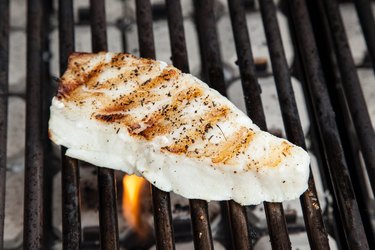
You know you need to add more fish to your diet, but you may be wary about adding this protein if you don't know how to prepare it. With its rich, moist flavor and tender flaky flesh, grilling sea bass is a lot easier than you may think.
Here, we're talking grilled Chilean sea bass, including a simple recipe on how to grill it to perfection.
Video of the Day
Video of the Day
Chilean Sea Bass Nutrition
The Dietary Guidelines for Americans recommend that you eat a variety of protein foods, including 8 ounces of seafood a week, which includes grilled sea bass. According to the USDA, a 3-ounce serving of cooked sea bass contains:
- Calories: 105
- Total fat: 2.2 g
- Cholesterol: 45.1 mg
- Total carbs: 0 g
- Fiber: 0 g
- Sugar: 0 g
- Protein: 20.1 g
Protein is an essential nutrient found in every cell, tissue and organ in your body. It's needed to build and repair your body, support immune health and assist your body in many essential processes. Although Americans certainly eat enough protein, most of it comes from chicken and beef, according to an August 2015 study in the journal Nutrients.
Chilean sea bass is also a good source of omega-3 fatty acids, with 49 percent of your recommended amount in a 3-ounce cooked serving. These essential fats are important for brain health and may improve heart health by lowering blood pressure and improving blood vessel function, according to the Harvard T.H. Chan School of Public Health.
Be Mindful of Mercury
Chilean sea bass is a great source of protein and omega-3 fatty acids, but it's also a source of mercury. This naturally occurring toxic metal can affect your nervous and digestive systems and damage your liver, kidneys and skin. Although mercury is found in the air and water, fish is the primary source of the toxic metal, reports the World Health Organization.
However, the amount of mercury in fish varies significantly. Fish that are low in mercury include flounder, tilapia and salmon. The Food and Drug Administration says you can eat two to three 4-ounce servings of low-mercury fish each week.
Chilean sea bass is considered a moderate source of mercury, so you should eat no more than one serving of this fish each week. Black sea bass is low in mercury, so you can enjoy it two to three times a week.
If you're pregnant or nursing, you should only eat low-mercury fish, which means Chilean sea bass is off the menu. Mercury exposure can lead to permanent brain damage in a developing baby.
Grilling Sea Chilean Bass Like a Pro
Grilling is an easy way to prepare any fish, including Chilean sea bass. The Washington State Department of Health says the general rule of thumb for fish is 10 minutes of cooking time for every inch of thickness.
For food safety, cook your fish until it reaches an internal temperature of 145 degrees Fahrenheit, per the U.S. Department of Health & Human Services.
Simple Grilled Chilean Sea Bass Recipe
- Before you prepare your grilled sea bass, heat your grill or grill pan to medium heat.
- Coat your Chilean sea bass with olive oil and season with salt and pepper. For a more flavorful fish, consider adding other seasonings before you place the fish on the grill. For example, try using dill and lemon, paprika and garlic powder, or orange zest and thyme.
- For a 1-inch-thick fillet of Chilean sea bass, grill for 10 minutes or until the fish has reached an internal temperature of 145 F.
- Turn your grilled sea bass halfway through the cooking time so it cooks evenly.
For a complete dish, serve your grilled Chilean sea bass with roasted corn or our Grilled Veggie Quinoa Salad, which has 219 calories per 1-cup serving.
- Nutrients: "Sources and Amounts of Animal, Dairy, and Plant Protein Intake of US Adults in 2007–2010"
- Health.gov: "Dietary Guidelines for Americans, 2015-2020: "Appendix 3. USDA Food Patterns: Healthy U.S.-Style Eating Pattern"
- USDA FoodData Central: FoodData Central: "Chilean Seabass"
- Lipids: "Fatty Acid Profiles of Commercially Available Finfish Fillets in the United States"
- Harvard T.H. Chan School of Public Health: "Fish: Friend or Foe?"
- World Health Organization: "Mercury and Health"
- Food and Drug Administration: "Advice About Eating Fish"
- Washington State Department of Health: "Healthy Fish Recipes"
- FoodSafety.gov: "Safe Minimum Cooking Temperatures"